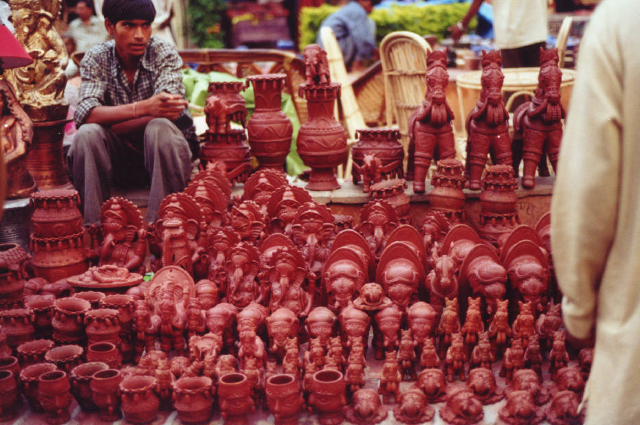Delhi Haat, a vibrant cultural hub nestled in the heart of India's capital, is a kaleidoscope of colours, scents, and craftsmanship. When you enter this eclectic market, the air is filled with a palpable energy, a harmonious blend of tradition and modernity. The unique charm of Delhi Haat lies in its ability to encapsulate India's diverse cultural heritage under one roof.
A day at Delhi Haat begins with an overload of the senses – the aroma of spices, the vibrant hues of textiles, and the symphony of artisans at work. As you walk between the stalls, each representing a different state or region, it's clear that Delhi Haat is more than just a market; it is a living canvas depicting the rich tapestry of Indian traditions.
Begin your exploration with hand-made textiles, a range of fabrics that tell the stories of generations. From the vibrant Phulkari of Punjab to the intricate Banarasi silk, each piece is a testament to the skill and artistry of Indian weavers. Connect with the artisans, witness the looms in action, and unravel the stories woven into each thread.
Delhi Haat is not just a shopping destination; it is an immersion in the culinary diversity of India. Embark on a culinary journey between stalls offering delicacies from different states (UP, Maharashtra, Assam, Manipur, Kashmir). Savor the fiery flavors of Delhi's street food or indulge in the fragrant biryani of Hyderabad. The common seating areas provide the perfect environment to enjoy these culinary specialties while absorbing the lively atmosphere.
As the afternoon sun bathes the Delhi Haat in golden hues, take in the cultural performances that take place on the central stage. Traditional dances, folk music, and live performances transport you to the heart of each state, celebrating the diversity that defines India. It is a reminder that Delhi Haat is not just a marketplace; it is a cultural melting pot where traditions come alive.
While Delhi Haat embraces tradition, it also encourages innovation. Explore contemporary art stalls where young artists showcase their modern interpretations of Indian culture. The fusion of traditional and contemporary art forms creates a dynamic visual experience that reflects India's ever-evolving identity.
For a moment of peace, visit the meditation and wellness corner. In the midst of the bustling market, find solace in yoga classes or indulge in Ayurvedic therapies. Delhi Haat, in its uniqueness, caters to both those who seek tradition and those who long for a quiet escape in the city.
Handicrafts at Delhi Haat go beyond aesthetics; they tell stories about sustainability and environmental friendliness. Discover stands dedicated to upcycled and recycled products, where creativity meets environmental awareness. From handmade paper to recycled textiles, these stalls exemplify a commitment to both culture and the environment.
Connect with artisans and women, hear their stories, and understand the labor of love that goes into each creation. Delhi Haat is not just a marketplace; it is a space where human connections are made, where the exchange is not just monetary but a celebration of skill, passion, and heritage.
As the day draws to a close, consider attending a workshop or demonstration. From ceramics to block printing, these sessions offer a hands-on experience that allows you to be part of the creative process. It is a rare opportunity to take home not only a product but also a piece of the craftsman's soul.
In the fading twilight, Delhi Haat transforms into a magical realm, illuminated by traditional lanterns and the warmth of camaraderie. The evening market comes alive and represents another aspect of the cultural extravaganza. The stalls, now decorated with twinkling lights, cast a spell and invite you to linger a little longer.
A day at Delhi Haat is not just a shopping spree; it is a journey through India's heritage, a celebration of its diversity, and an immersive experience that transcends the boundaries of time. As you leave the gates, laden with treasures and memories, you carry with you a piece of India's soul, etched forever in the vibrant tapestry of the Delhi Haat.
Here one thing only which is not on the good side is that, unfortunately, cheap imported Chinese products are starting to be sold at Dilli Haat, which is disappointing and worrying. This is due to the fact that an increasing number of stalls are occupied by middlemen and traders rather than real craftsmen.
Regular festivals are held in every Dilli Haat. These include the Great Indian Food Festival in January, the Baisakhi Festival in April, the Summer Festival in June, the International Mango Festival in July, and the Teej Festival in August. Another highlight is the regional folk dances.
We can say Delhi Haat, a vibrant cultural bazaar, offers a Kaleidoscope of Indian crafts, cuisine, and performing arts. Its unique concept, combining traditional market charm with modern amenities, creates a rich tapestry of experience for visitors. The diverse handicrafts and regional delicacies make it a must-visit, showcasing India’s cultural mosaic.

